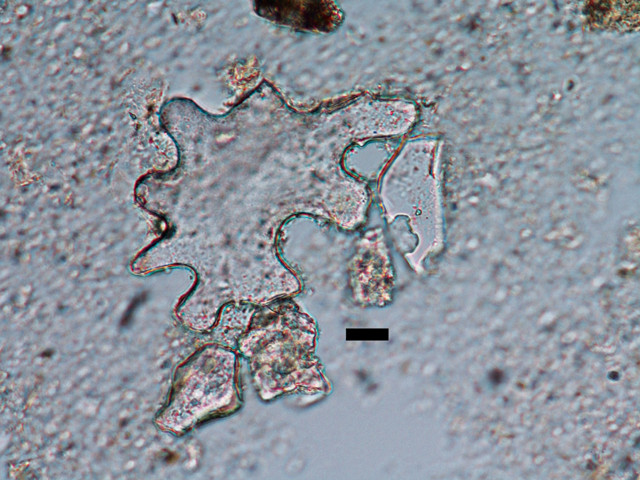
by David B. Williams Monday, June 1, 2015

Fossil plant phytoliths, like this 49-million-year-old example found in an ancient soil horizon in Patagonia, Argentina, may offer clearer views of past ecosystems. (Scale bar is 10 micrometers.) Credit: Regan Dunn.
A key part in understanding a terrestrial ecosystem is analyzing its vegetation structure: How dense is the foliage? Is its canopy open or closed? How much sunlight reaches the ground? Answering these questions about a modern plant community is relatively easy, but for paleoecosystems, such analysis has not been possible until recently. Now, a new study published in Science reports a novel way to create what lead author Regan Dunn calls a “3-D look” at ancient ecosystems.
Dunn, the paleobotany collections manager at the University of Washington’s Burke Museum of Natural History and Culture in Seattle, and colleagues in the U.S. and Argentina, were interested in understanding ecosystem change in Patagonia, Argentina, during the Cenozoic Period. Studies of pollen and leaves had provided part of the story, but Dunn’s team wanted a more precise method to analyze how past habitats might have driven evolution of tooth morphology in South American herbivores. So, the researchers turned to phytoliths — Greek for “plant stones” — collected from Patagonian sediments dating to the time period of interest.
Phytoliths form when plants take up silica from the soil and then precipitate it within certain tissues, essentially creating replicas of individual cells. (Why phytoliths are produced is not entirely clear, although they appear to provide some plants with structural support and defense against herbivores, as well as to confer other physiological benefits.) When a plant dies, leaves containing microscopic phytoliths — which vary in appearance depending on plant type — settle into the soil. Because hard phytoliths often fossilize while soft plant parts do not, they are critical for understanding past ecosystems, Dunn says.
Dunn and her team hypothesized that the size and shape of phytoliths formed in the outermost, or epidermal, layer of leaf cells should reflect the canopy structure of the ecosystem in which the leaves grew. In shade, leaves produce epidermal cells that are larger and more irregular in shape than those made by leaves receiving full sunlight. Consequently, a more closed habitat with denser vegetation should produce larger epidermal phytoliths with more sinuous surfaces.
To test their idea, the scientists also studied modern phytoliths from Costa Rica, sampling soils from a range of open and closed habitats, and comparing how the phytoliths’ sizes and shapes corresponded to canopy coverage. They found that the Costa Rican phytoliths’ size and sinuousness correlated well with the leaf area index (LAI) — a common proxy for vegetation and canopy structure, which relates directly to the amount of sunlight reaching leaves — in the modern plant communities.
Applying their approach to the Patagonian phytoliths, Dunn and her team found that the region lacked grasslands between 49 million and 11 million years ago, and that it became drier and more open earlier than previously thought. By the Late Eocene, dense, broadleaf forests had been replaced by open forests and shrubland habitats, which mostly dominated the area through the Middle Miocene. The shift may be related to climatic changes at the time, including cooling ocean temperatures, and is also reflected in the evolution of herbivore teeth in the region, which became better suited to consuming plants growing in open, arid environments, the researchers suggested.
Before this study, Dunn says, paleoecologists could broadly say that a particular site had an open or closed habitat, but this left a wide range of variability. The new technique allows for a more complete reconstruction of past environments, she says. And because canopy density influences photosynthesis, researchers have a much fuller picture of ecosystem dynamics such as carbon storage, greenhouse gas production and aridity in an environment. “Phytoliths provide an entirely new way to see past environments,” Dunn says.
© 2008-2021. All rights reserved. Any copying, redistribution or retransmission of any of the contents of this service without the expressed written permission of the American Geosciences Institute is expressly prohibited. Click here for all copyright requests.